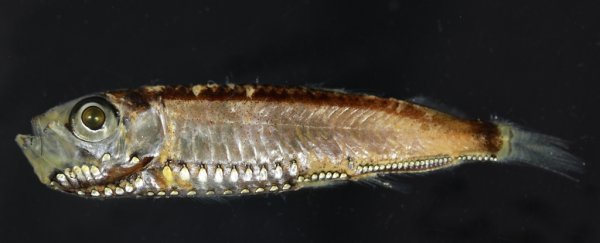Unlike other fish that share its habitat, the deep-sea pearlside is active at dusk and dawn - a behaviour referred to as crepuscular, meaning it's neither nocturnal or diurnal.
And now it turns out this fish has an eye cell that works differently from any other light-sensing cell researchers have encountered - and it might even be more efficient.
You may have heard that the vision receptors in most vertebrate retinas, including our own, have two different photoreceptor (or light-sensing) cell types called cones and rods.
Cones work optimally when there are high light levels, such as daytime. Rods are more sensitive to light differences, so we rely on them more in low light. (Mammals also have a third type of photoreceptor cell, but that's not relevant to this story about fish.)
Deep-sea fish live in the deep, dark ocean where the Sun's rays don't penetrate. Therefore, most such species have lost their cone cells entirely, and only have rod cells left in their eyes.
Pearlsides (Maurolicus spp.), however, come close to the surface at dawn and dusk, when there is some light.
But researchers have discovered that their eyes are neither like those of other deep-sea fish, nor those of crepuscular animals.
"Previously it was thought that pearlsides had retinas composed entirely of rods, but our new study has found this isn't the case," said researcher Fanny de Busserolles of the Queensland Brain Institute.
Many species use a combination of their rods and cones, called mesopic vision, in low to moderate light conditions.
Humans use this for low light, as do crepuscular species. Cats, for instance, use cone cells but have more rod cells for better night and twilight vision.
"Pearlsides, being active mainly during twilight, have developed a completely different solution," said de Busserolles.
"Instead of using a combination of rods and cones, they combine aspects of both cells into a single and more efficient photoreceptor type."
The researchers have called these newly discovered cells "rod-like cones," because under a microscope they appear to be a combination of both types of cells.
The discovery, according to lead researcher Justin Marshall, shows how easy it is to make assumptions - and even when we think we have the answers, nature can still surprise us.
"Humans love to classify everything into being either black or white," he said.
"However, our study shows the truth might be very different from previous theories. More comprehensive studies, and caution, are needed when categorising photoreceptor cells into cones and rods."
The research has been published in the journal Science Advances.
